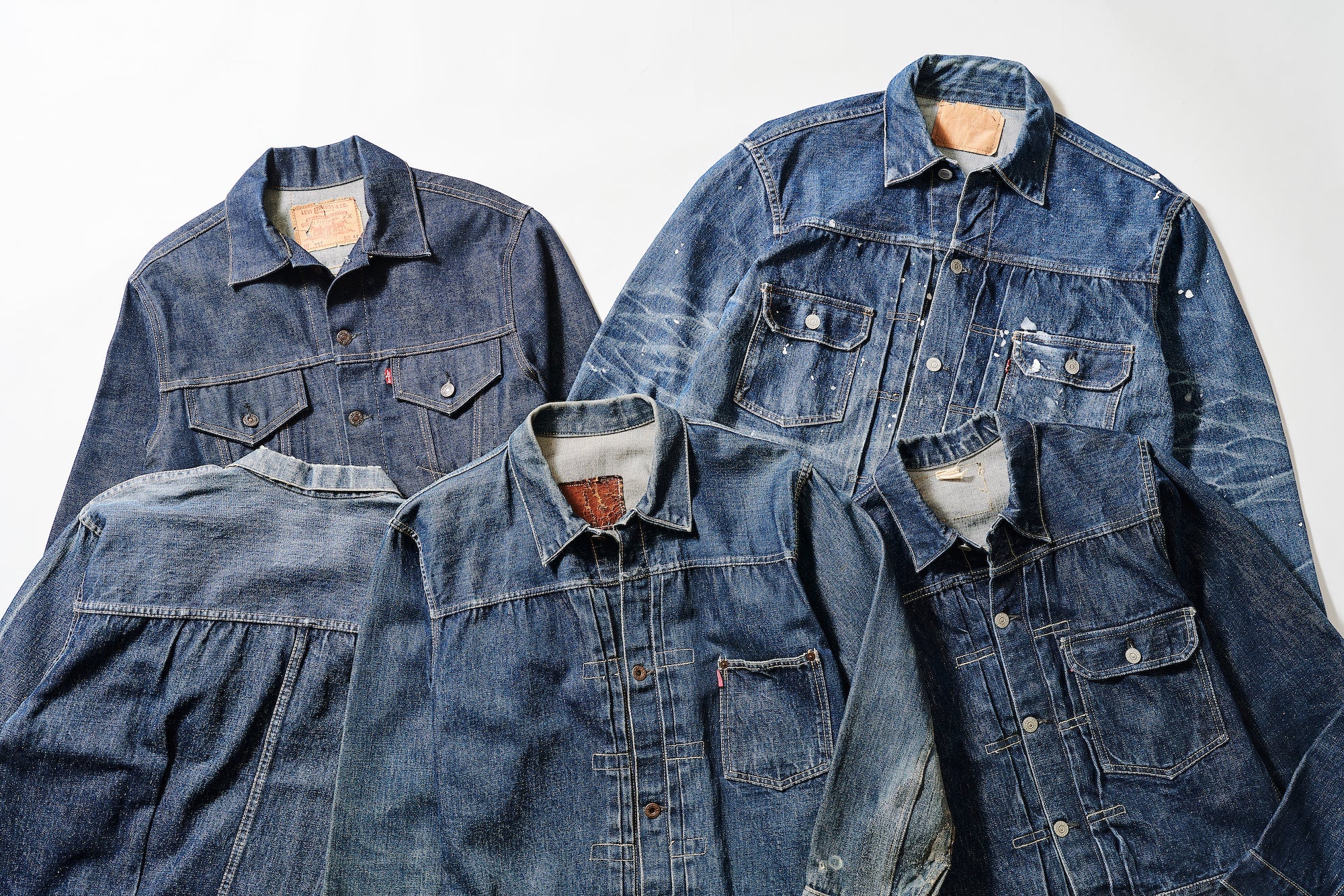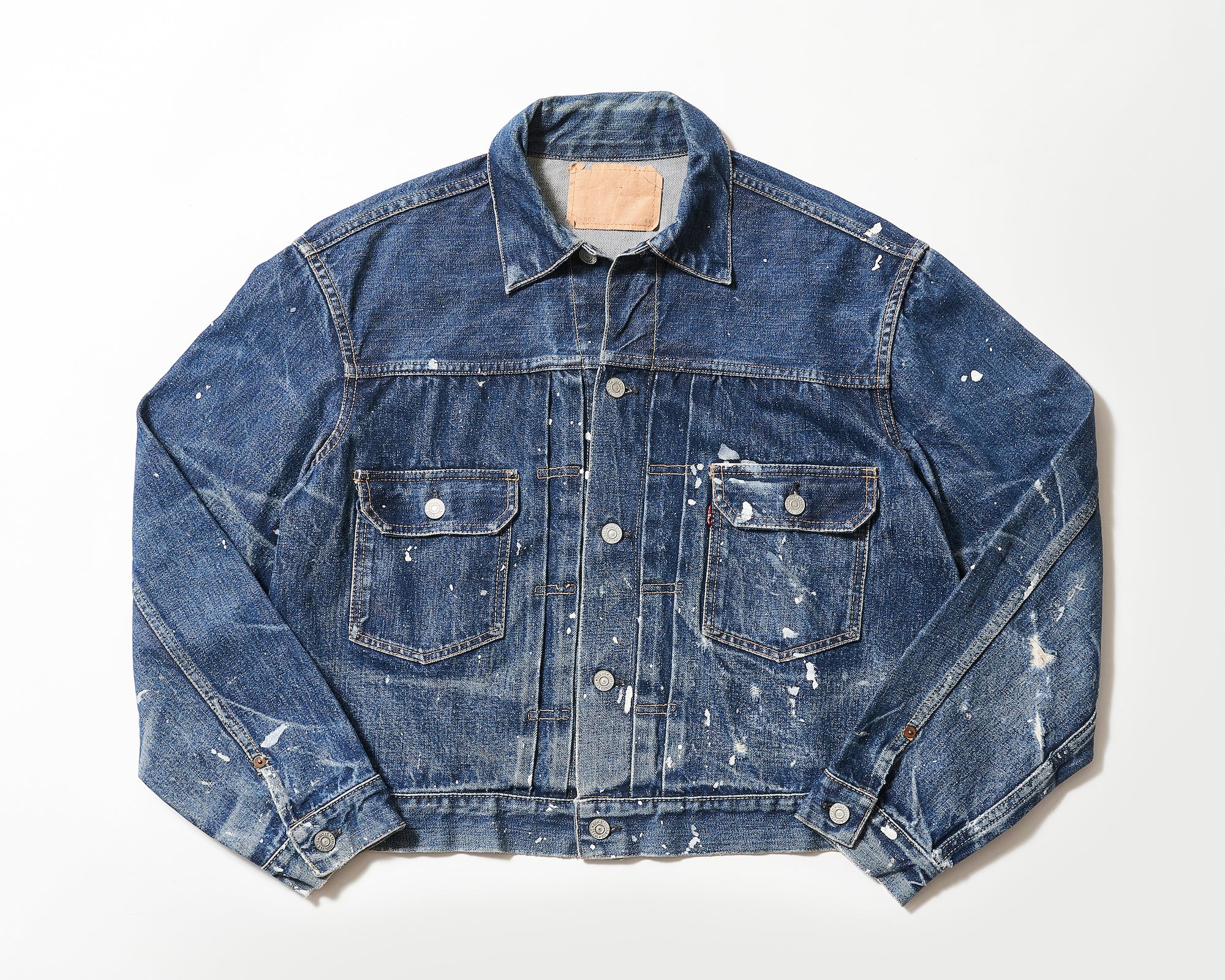Vintage Clothing Prep School Lecture 1: The origin and the pinnacle. The Levi's®️ denim jacket, which became the template for the scene.
Lecturer: Yu Fujiwara




BerBerJin Director / Vintage Denim Advisor
Born in 1977, he is a world-renowned denim maestro who is the director of BerBerJin, a long-established vintage shop in Harajuku, and is also known for overseeing "THE 501®XX A COLLECTION OF VINTAGE JEANS," the world's first archive book to systematically compile the history of Levi's® 501®XX, and "Levi's VINTAGE DENIM JACKETS Type l/Type ll/Typel lll," which marked the beginning of the recent denim jacket boom.
Instagram: @yuttan1977
Do you remember the first vintage denim jacket you ever owned?
Of course. The first one I got was a 70505E, commonly known as 4th or Type 4, at a local thrift store when I was in high school. I had already gotten my hands on a 501E, so I wanted to stretch out a little and enjoy a set-up with a jacket from the same era as much as possible. I was also interested in older vintage models such as the 506XX (Type 1) and 507XX (Type 2), but the Type 1 cost 250,000 to 300,000 yen and the Type 2 was about 150,000 yen, so they were out of my reach for my wallet at the time.

I heard that the next one you got was actually the Type 1?
That's right. I joined BerBerJin when I was 21, and the following year I started going on buying trips, and one of my regular customers asked me to buy it if I could find a large Type 1 jacket with two pieces spliced together at the back. Of course, I had never seen anything like it myself, but Zip (current owner of HTC), who was a big name vintage dealer at the time, was a big guy himself, so I thought maybe I could get some information from him.
So I went to visit him right away, and he told me that he had some dead stock in size 50, and it was the first time I'd ever seen one with a T-shaped split back. But of course he wouldn't give it to me, and instead asked me to give it to him if I found it after I returned to Japan, because he said, "No Japanese person would wear something this big."
It seems like they ordered the wrong thing (laughs).
After that, I started to search privately in Japan for a larger size pair with a two-piece back. At the time, the standard size was still 38 or 40, so it was hard to find anything, but then I saw a pair in a lighter color and size 46 at a local shop. At that time, the vintage boom had calmed down a bit, and a lighter Type 1 that was the right size could be bought for around 80,000 to 100,000 yen, but this larger pair was being sold at an even lower price. That was my first Type 1, the model that would later be called T-back.
Is that to give to a regular customer, or as your own personal possession?
As a personal item (laughs).
That would get you in trouble (laughs).
When I stood in the store wearing it, as expected, people asked me, "What's that about?", and I ended up giving it to the regular customer (laughs). However, I had already told my friends in Kansai and other regions to let me know if they found a larger pair, and I had actually already secured the next Type 1 thong through their connections, but when it actually arrived, it was about size 50, which was too big for that time... In the end, I split the cost with my friends and bought it as a birthday present for my friend. The next pair I got was a '47 model, about size 46, which happened to be in stock at our store (BerBerJin), and I wore it for about two years. After that, a vintage shop in Hawaii that was praised as the best in the world at the time was closing, so we decided to buy all the products in the domestic warehouse. That's where I found the thong I'm still wearing today. I've been buying new ones over and over until now.
Originally, just the right size was expensive and big sizes were cheap, but when did these value standards start to reverse?
I remember it was around 2004-2005 when I got my third Type 1. Due to the nature of Type 1, if you choose the exact size, the length will inevitably be too short, the shoulders will not droop, and it will be difficult to match with modern sensibilities. Because of this, the number of users looking for larger sizes gradually increased, and the price reversal phenomenon that continues to this day occurred.

Nowadays, a thong alone can be worth millions, and some can even exceed 10 million yen depending on their condition, but during the vintage boom of the 90s, jeans of course reigned supreme, but denim jackets weren't really that prized. Why do you think the denim jacket has made a comeback?
To be honest, during the vintage boom, everyone felt a little embarrassed about wearing a set-up, and I think everyone was a little resistant to it. Then, in the early 2000s, denim was reevaluated due to the influence of hard-core seniors such as Henmi-san (currently at Timeworn Clothing) of Tenderloin at the time, and a generation that had never been into vintage clothing before started to become interested in vintage denim. In other words, there was a reverse trend from reproduction to vintage. In fact, during the same period, not only denim jackets but also many related vintage clothing became in demand after the breakthrough of homages and reproductions.
However, there are many other rival brands and store brands. What is the reason why Levi's® is so popular among them?
As the originator, I think it all comes down to the excellent level of perfection that cannot be changed. Starting with the work jacket, which was also called "blouse" at the time and made from denim fabric since the late 1800s, the Type 1, which officially debuted in the early 1900s, its successor, the Type 2, and the Type 3, which moved from work to fashion and became the template for the so-called "Denim jacket", it has always boasted outstanding originality and excellent perfection, so much so that many subsequent brands have made similar jackets throughout the ages.
As far as I know, Levi's® was the first in the world to develop a denim jacket with double pleats and one pocket, as seen in the Type 1, and they have always been pioneers in terms of design.

If you are going to get into vintage denim jackets, do you think Levi’s® is the best choice?
That's right. That being said, I think it's too difficult to jump straight into Type 1 or Type 2, so I recommend starting with Type 4 or 70505E. Even though the prices are gradually rising, they're still inexpensive and you can enjoy the unique aging of indigo, and you can wear them daily without worrying about the details.
Since the first 506XX was released in the early 1900s, three main models were developed until the 70505E was introduced in 1966, but there are actually quite a few irregular specifications that have been uncovered in recent years. From here, we will review the points you should keep in mind when choosing a vintage denim jacket, mainly focusing on Fujiwara's personal belongings.
Officially known as the Type 1, it debuted in the early 1900s. In 1941, two years after the outbreak of World War II, the Material Control Order was issued across the United States, and various restrictions were imposed on clothing from the following year. This model was produced during the early days of the control, a transitional period so to speak, and while it barely retains pre-control specifications such as flap pockets and a five-button front closure, the fabric is made of coarse-woven denim, which is synonymous with wartime models. The cinch buckle on the back, commonly known as the buckleback, was also painted black for only a few months between 1941 and 1942. The photo shows a detail that is only available in the big size, the so-called "T-back" model with two strips on the back.

In 1942, the Material Control Order also affected clothing manufacturers, and various changes to specifications that differed from peacetime were made mandatory. The initial S in front of the model name stands for Simplify. The front opening was changed from five buttons to four, and the same laurel buttons as those used on military rationed items were adopted. The flaps on the front pockets were also eliminated, and a coarsely woven fabric with a strong nap was used. It was only produced for about four years, from September 1942 until the end of the war in 1946, and due to its rarity, its price continues to soar worldwide. This model, with a leather patch sewn slightly lower, is from the mid-war period and is commonly known as the Down Patch. 5.5 million yen (BerBerJin)

Production of the wartime models continued for a few months after the end of the war in 1945, and they were finally restored to their original specifications in 1947. However, there are of course some subtle differences when compared to pre-war models. The pin-type cinch buckle is larger, and the lettering engraved on the rivet is slightly more centered. It was manufactured for about seven years until the appearance of its successor, the 507XX, but due to criticism that the buckle needles would scratch car seats, later models were changed to slide buckles. 1.1 million yen (BerBerJin)

The so-called Type 2 was introduced in 1953. The front had two pockets, the back adjuster changed from a buckle to a button, and in 1954, the white name of the red tab, which is a proof of Levi's®, was woven on both sides. After the Type 3 was introduced in 1961, it was usually discontinued, but in recent years, even a small paper patch version was found, which was adopted from Type 4 onwards, and although the reason is unclear, it is believed to have been produced until the late 1960s. Due to the design of the armhole, the length is shorter than Type 1 even if it is the same size, and one of the major features is that the cufflinks are upside down.

The 557, commonly known as Type 3, which became the model for today's denim jackets, debuted in 1961, at the beginning of the 60s, when denim had become more and more fashionable. The double pleats on the body were eliminated, and a V-shaped stitching running from the yoke to the waist was introduced, and it was produced for about seven years until the appearance of its successor, the 70505 (Type 4). The first model was known as the 557XX with a paper patch that read "Every Garment Guaranteed," followed by the 557XX, 557, and 557-70505. The metal buttons were also replaced with copper, and the denim fabric was changed to pre-shrunk denim that had been treated to prevent shrinkage.